Instructions for Transporters
DO NOT TRANSPORT WITH WHEELS ON THE GROUND
The rear motor in Model 3Model Y generates power when the wheels spin. Always transport Model 3Model Y with all four tires off the ground. Ensure that the tires are unable to spin at any time during transport.




Do not transport Model 3Model Y using any method that is not specified by Tesla. Adhere to the instructions provided in the following sections and observe all warnings and cautions provided. Damage caused by improper transporting of your vehicle is not covered by the warranty.
Approved Methods for Transporting
A flatbed truck or comparable transport vehicle is the recommended method of transporting Model 3Model Y. The vehicle can face either direction when using a flatbed.

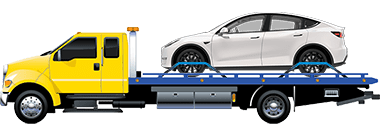
If Model 3Model Y must be transported without a flatbed truck, then wheel lifts and dollies must be used to ensure that all four wheels are off of the ground. This method may only be used for a maximum of 35 miles (55 km), and must not exceed the manufacturer speed rating of the dollies. With this method, Tesla recommends the vehicle facing forward so that the front wheels are lifted and the rear wheels are on dollies.


Activate Transport Mode
Transport Mode keeps the parking brake disengaged while winching Model 3Model Y onto a flatbed truck. When active, Transport Mode displays a message indicating that the vehicle will remain free-rolling. The following are required to enable Transport Mode:
- 12V power is required. You are unable to use the touchscreen to activate Transport Mode if Model 3Model Y has no power.
- Model 3Model Y must detect a key. Transport Mode is available only when a key is detected.
To activate Transport Mode:
- Ensure the vehicle is in Park.
- Chock the tires or otherwise ensure Model 3Model Y is secure.
- Press and hold the brake pedal, then on the touchscreen, touch . The touchscreen displays a message reminding you how to properly transport Model 3Model Y.
- Press and hold the Transport Mode button until it turns blue. Model 3Model Y is now free-rolling and can slowly be rolled (no faster than walking speed) or winched.
To cancel Transport Mode, shift Model 3Model Y into Park.
Pull onto the Flatbed Truck
- Locate the tow eye. The tow eye is located under the carpet in the front trunk.
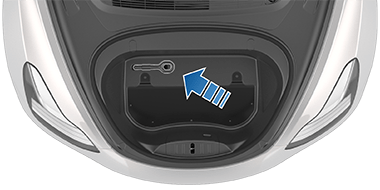
- Release the tow eye cover by pressing firmly on its top right perimeter until it pivots inward, then gently pulling the raised section toward you.Note: The tow eye cover is connected to the vehicle's black negative (-) terminal.
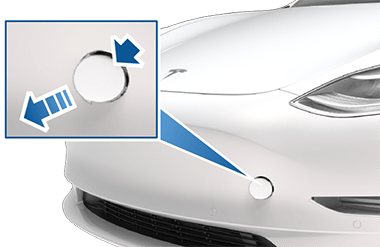
- Fully insert the tow eye into the opening, then turn it counter-clockwise until securely fastened.
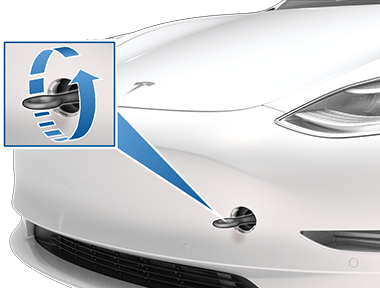
- Attach the winch cable to the tow eye.CAUTION: Before pulling, make sure the tow eye is securely tightened.
- Activate Transport Mode.
- Pull Model 3Model Y slowly onto the flatbed truck.
Pull Onto Flatbed Truck From Front
- Locate the tow eye. The tow eye is located in the front trunk.
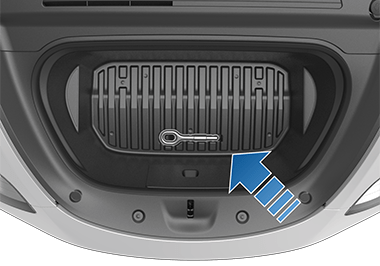
- Release the front tow eye cover by pressing firmly on its top right perimeter until it pivots inward, then gently pulling the raised section toward you.Note: The front tow eye cover is connected to the vehicle's black negative (-) terminal.

- Fully insert the tow eye into the opening, then turn it counter-clockwise until securely fastened.

- Attach the winch cable to the tow eye.CAUTION: Before pulling, make sure the tow eye is securely tightened.
- Activate Transport Mode.
- Pull Model 3Model Y slowly onto the flatbed truck.
Pull Onto Flatbed Truck From Rear
- Locate the tow eye. The tow eye is located in the front trunk.

- Release the rear tow eye cover by pressing firmly on its top right perimeter until it pivots inward, then gently pulling the raised section toward you.Note: Vehicles equipped with a hitch receiver cannot be pulled from the rear tow eye. Use the tow bar or hitch receiver only to pull the vehicle to a safe location, such as onto a flatbed truck. Do not transport the vehicle with wheels on the ground.
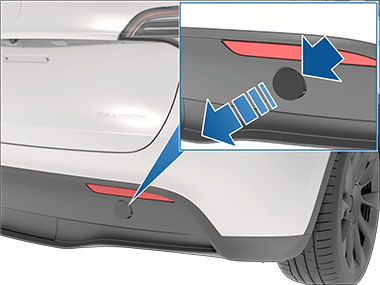
- Fully insert the tow eye into the opening, then turn it counter-clockwise until securely fastened.
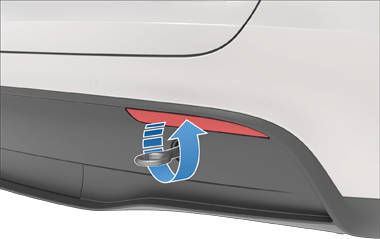
- Attach the winch cable to the tow eye.CAUTION: Before pulling, make sure the tow eye is securely tightened.
- Activate Transport Mode.
- Pull Model 3Model Y slowly onto the flatbed truck.
Secure the Tires
The vehicle's tires must be secured onto the truck using the eight-point tie-down method.
- Ensure any metal parts on the tie-down straps do not contact painted surfaces or the face of the wheels.
- Do not place tie-down straps over body panels or through the wheels.
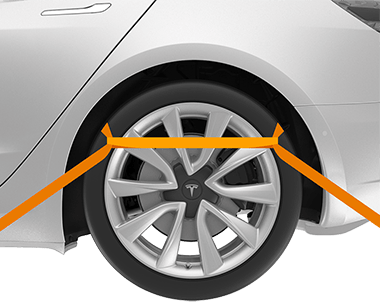
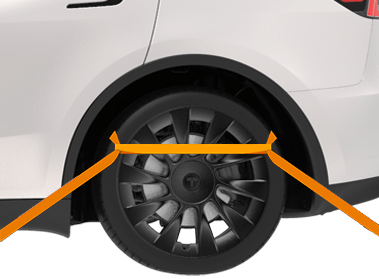
If Vehicle Has No Power
If Model 3Model Y has no 12V power, perform the following steps to open the hood or jump start the auxiliary 12V battery.
Jump Starting the 12V Battery
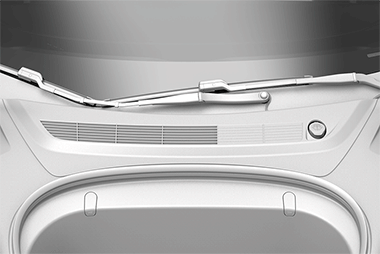
- Open the hood (see Opening Hood with No Power).
- Remove the maintenance panel by pulling it upwards to release the trim clips that hold it in place.
- Remove the cabin intake trim panel by pulling it upwards to release the trim clips that hold it in place.
- If equipped with a HEPA filter, carefully fold the HEPA filter gasket towards the front of the vehicle to gain access to the 12V battery.Note: Space to access the 12V battery is limited. Consider removing the push clips from the rear cowl to improve accessibility.
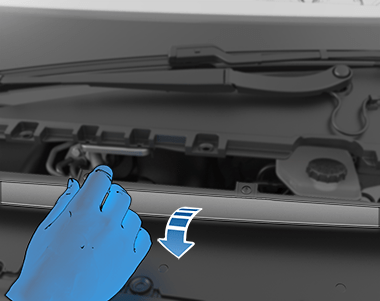
- Connect the 12V power supply's red positive (+) cable to the red positive (+) terminal on the 12V battery.CAUTION: To avoid damaging Model 3Model Y, do not allow the positive cable to contact other metal components, such as the battery tie-down bracket.
- Connect the 12V power supply's black negative (-) cable to the black negative (-) terminal on the 12V battery.
- Turn on the external power supply (refer to the manufacturer’s instructions). Touch the touchscreen to wake it up.Note: It may take several minutes to receive enough power to wake up the touchscreen.
- When external 12V power is no longer required, disconnect both cables from the terminals on the 12V battery, beginning with the black negative (-) cable.
- Reinstall the cabin intake trim panel by placing it back in its original location and pressing down until it is secure.
- Replace the maintenance panel by placing it back in its original location and pressing down until it is secure.
- Close the hood.